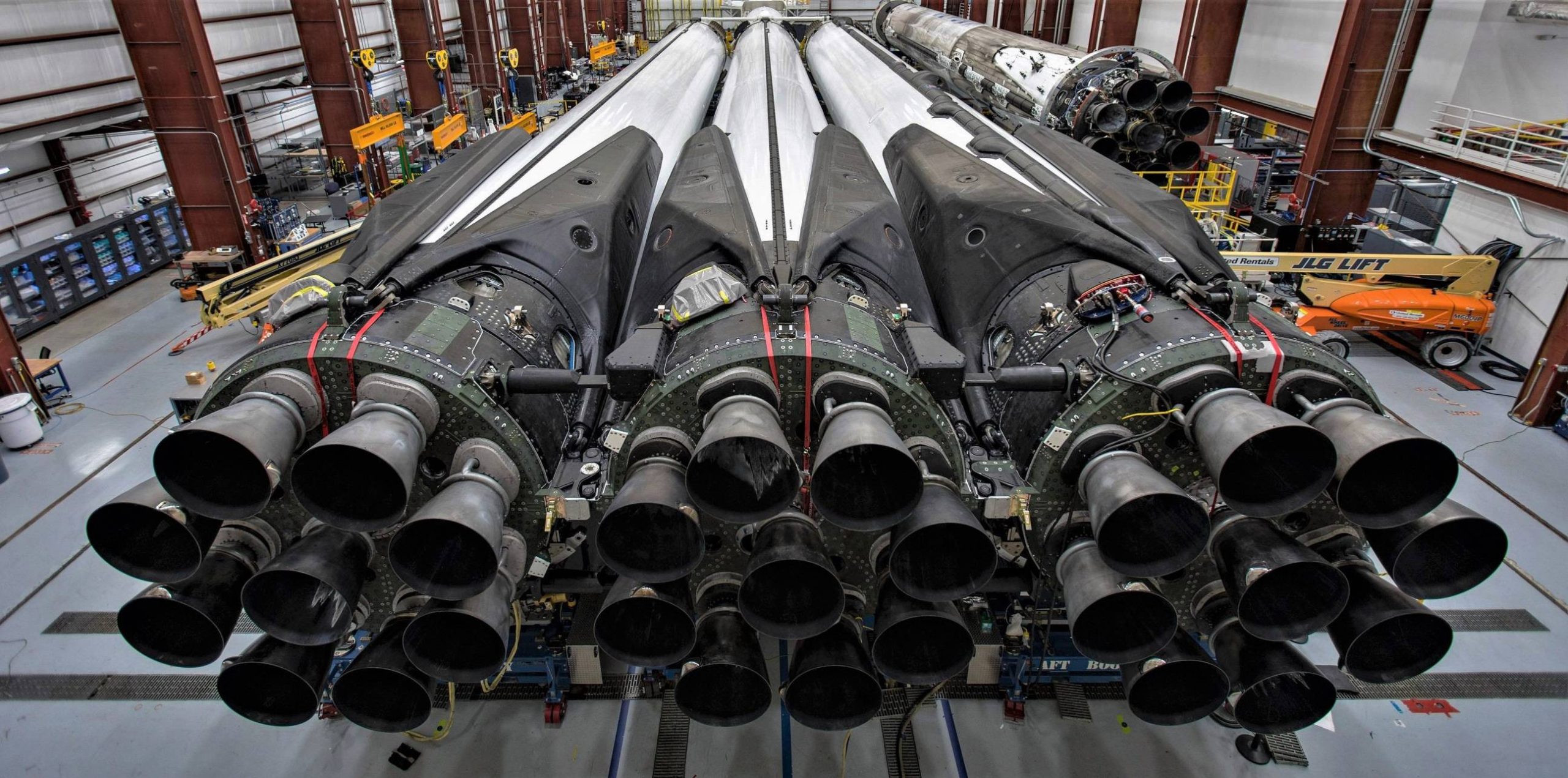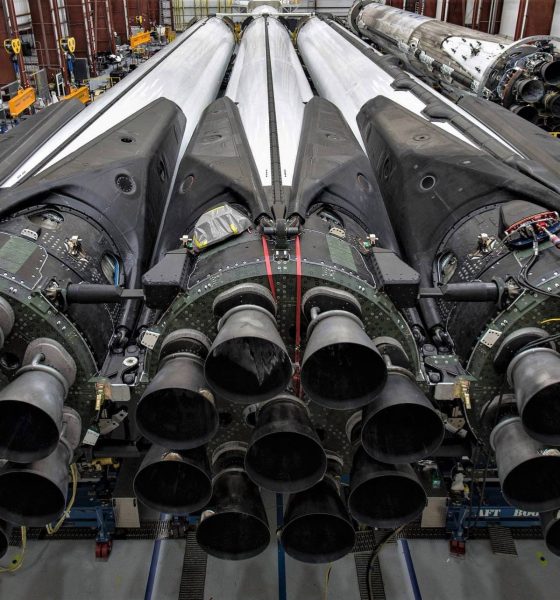

SpaceX
SpaceX reveals Falcon Heavy Block 5 in first official photo, timelapse
SpaceX has revealed the first official media (including a timelapse video) of its Falcon Heavy Block 5 rocket, including one of the most spectacular photos of Falcon Heavy (and the Falcon family in general, for that matter) ever.
Over a period of 24-48 hours in early April, SpaceX technicians and engineers completed Falcon Heavy Flight 2’s final integration, attaching the side boosters to the center core and the rocket’s upper stage to its interstage. After assembled, cranes lifted the massive rocket – likely weighing upwards of 75 metric tons (165,000 lb) – and carefully installed it on Pad 39A’s transporter/erector (T/E), a large mobile structure that houses hold-down clamps and fueling/communications hardware, as well as the ability to lift the rocket vertical and horizontal. Soon after, the rocket rolled out to Pad 39A and performed its first integrated static fire, paving the way for a launch date as early as 6:35 pm EDT (22:35 UTC), April 9th.
Alongside the unique
Offered in 4K resolution, the photo is perhaps the most detailed official look yet at a Block 5 rocket, particularly so for a view of the engine section, octaweb, and heat shielding of not one but four boosters. Immediately noticeable is an intriguing green patina present on each Falcon Heavy booster’s shield heat shield structure, sometimes described (humorously) as the dance floor. Prior to these three boosters, the same structure of other Falcon 9 Block 5 boosters has never featured the same patina, indicating that it is either a distinct modification (improved shielding, perhaps) or – more likely – a vestige of manufacturing that disappears during each Block 5 booster’s first high-speed reentry. In other words, it might be a patina or an anti-corrosion coating that is literally burned off in the process of landing.

Additionally, the complex mechanisms connecting the three Falcon 9-like boosters are also easily visible. Rough visual comparisons between the mechanisms present on Falcon Heavy Flight 1 and 2 suggest that they are largely unchanged. Their ultimate job is to safely, reliably, and repeatedly transfer truly horrifying loads – at times, the majority of the thrust of both side boosters – with as little mass and aerodynamic disruption as possible, all while still successfully separating the three boosters and retracting thereafter. In a press conference shortly after Falcon Heavy’s successful launch debut, Musk repeatedly acknowledged that the additional hardware required – aside from a complete redesign for the center core – was an extraordinary engineering challenge, far harder than he had expected it would be.


Additionally, SpaceX confirmed that the fourth booster present inside 39A’s main hangar was Falcon 9 B1051, the same rocket that launched Crew Dragon into orbit for the first time one month ago. According to the Canadian Space Agency (CSA), B1051 is being refurbished for its Radarsat Constellation Mission (RCM), a trio of satellites planned to launch from Vandenberg Air Force Base (VAFB) no earlier than May 2019. Over the course of the Falcon Heavy integration timelapse, B1051 can be seen rotating on its rocket rotisserie as technicians work to rapidly turn the rocket around for its second launch.

Check out Teslarati’s Marketplace! We offer Tesla accessories, including for the Tesla Cybertruck and Tesla Model 3.

Elon Musk
SpaceX issues statement on Starship V3 Booster 18 anomaly
The incident unfolded during gas-system pressure testing at the company’s Massey facility in Starbase, Texas.

SpaceX has issued an initial statement about Starship Booster 18’s anomaly early Friday. The incident unfolded during gas-system pressure testing at the company’s Massey facility in Starbase, Texas.
SpaceX’s initial comment
As per SpaceX in a post on its official account on social media platform X, Booster 18 was undergoing gas system pressure tests when the anomaly happened. Despite the nature of the incident, the company emphasized that no propellant was loaded, no engines were installed, and personnel were kept at a safe distance from the booster, resulting in zero injuries.
“Booster 18 suffered an anomaly during gas system pressure testing that we were conducting in advance of structural proof testing. No propellant was on the vehicle, and engines were not yet installed. The teams need time to investigate before we are confident of the cause. No one was injured as we maintain a safe distance for personnel during this type of testing. The site remains clear and we are working plans to safely reenter the site,” SpaceX wrote in its post on X.
Incident and aftermath
Livestream footage from LabPadre showed Booster 18’s lower half crumpling around the liquid oxygen tank area at approximately 4:04 a.m. CT. Subsequent images posted by on-site observers revealed extensive deformation across the booster’s lower structure. Needless to say, spaceflight observers have noted that Booster 18 would likely be a complete loss due to its anomaly.
Booster 18 had rolled out only a day earlier and was one of the first vehicles in the Starship V3 program. The V3 series incorporates structural reinforcements and reliability upgrades intended to prepare Starship for rapid-reuse testing and eventual tower-catch operations. Elon Musk has been optimistic about Starship V3, previously noting on X that the spacecraft might be able to complete initial missions to Mars.
Elon Musk
SpaceX Starship Version 3 booster crumples in early testing
Photos of the incident’s aftermath suggest that Booster 18 will likely be retired.

SpaceX’s new Starship first-stage booster, Booster 18, suffered major damage early Friday during its first round of testing in Starbase, Texas, just one day after rolling out of the factory.
Based on videos of the incident, the lower section of the rocket booster appeared to crumple during a pressurization test. Photos of the incident’s aftermath suggest that Booster 18 will likely be retired.
Booster test failure
SpaceX began structural and propellant-system verification tests on Booster 18 Thursday night at the Massey’s Test Site, only a few miles from Starbase’s production facilities, as noted in an Ars Technica report. At 4:04 a.m. CT on Friday, a livestream from LabPadre Space captured the booster’s lower half experiencing a sudden destructive event around its liquid oxygen tank section. Post-incident images, shared on X by @StarshipGazer, showed notable deformation in the booster’s lower structure.
Neither SpaceX nor Elon Musk had commented as of Friday morning, but the vehicle’s condition suggests it is likely a complete loss. This is quite unfortunate, as Booster 18 is already part of the Starship V3 program, which includes design fixes and upgrades intended to improve reliability. While SpaceX maintains a rather rapid Starship production line in Starbase, Booster 18 was generally expected to validate the improvements implemented in the V3 program.
Tight deadlines
SpaceX needs Starship boosters and upper stages to begin demonstrating rapid reuse, tower catches, and early operational Starlink missions over the next two years. More critically, NASA’s Artemis program depends on an on-orbit refueling test in the second half of 2026, a requirement for the vehicle’s expected crewed lunar landing around 2028.
While SpaceX is known for diagnosing failures quickly and returning to testing at unmatched speed, losing the newest-generation booster at the very start of its campaign highlights the immense challenge involved in scaling Starship into a reliable, high-cadence launch system. SpaceX, however, is known for getting things done quickly, so it would not be a surprise if the company manages to figure out what happened to Booster 18 in the near future.
Elon Musk
SpaceX’s next project will produce Starships at a level that sounds impossible
1,000 rockets per year is an insane number, especially considering Starship’s sheer size.

Elon Musk has revealed bold plans for SpaceX’s newest Starbase facility in Texas, predicting it will become a birthplace for “so many spaceships.” The upcoming “Gigabay,” a massive $250 million production hub in Starbase, Texas, is designed to manufacture up to 1,000 Starship rockets per year.
That’s an insane number of rockets for a single facility, especially considering Starship’s sheer size.
One of the world’s largest industrial structures
SpaceX’s Gigabay is expected to stand roughly 380 feet tall and enclose 46.5 million cubic feet of interior space, making it one of the largest industrial structures to date. The facility will feature 24 dedicated work cells for assembling and refurbishing Starship and Super Heavy vehicles, complete with heavy-duty cranes capable of lifting up to 400 U.S. tons, as noted in a Times of India report.
Construction crews have already placed four tower cranes on-site, with completion targeted for December 2026. Once operational, the Gigabay is expected to boost SpaceX’s launch cadence dramatically, as it would be able to build up to 1,000 reusable Starships per year, as noted in a report from the Dallas Express. Musk stated that the Gigabay will be “one of the biggest structures in the world” and hinted that it represents a major leap in Starbase’s evolution from test site to full-scale production hub.
A key step toward Mars and beyond
Starship is SpaceX’s heavy-lift rocket system, and it remains a key part of Elon Musk’s vision of a multiplanetary future. The vehicle can carry 100–150 tonnes to low Earth orbit and up to 250 tonnes in expendable mode. With several successful flights to date, including a perfect 11th test flight, the Starship program continues to refine its reusable launch system ahead of crewed lunar missions under NASA’s Artemis initiative.
Starship is unlike any other spacecraft that has been produced in the past. As per Elon Musk, Starship is a “planet-colonizer” class rocket, as the magnitude of such a task “makes other space transport task trivial.” Considering Starship’s capabilities, it could indeed become the spacecraft that makes a Moon or Mars base feasible.








